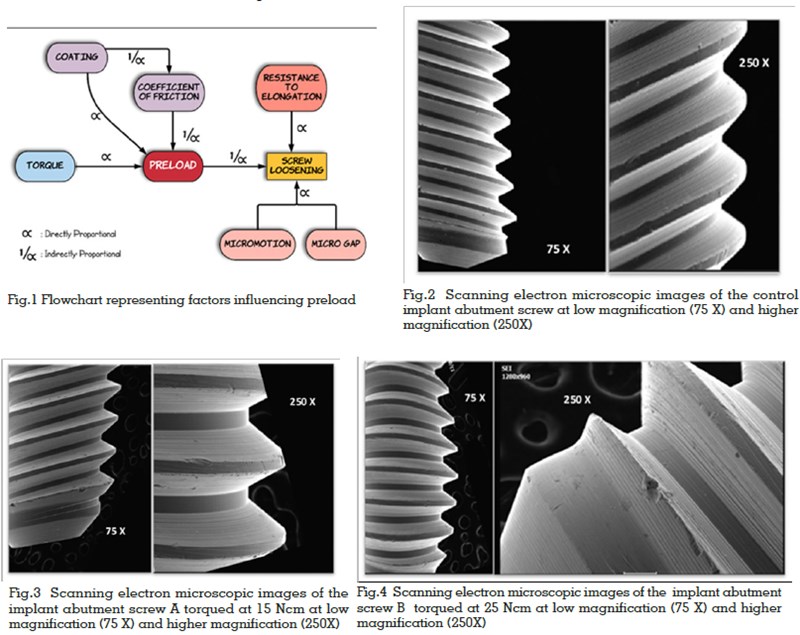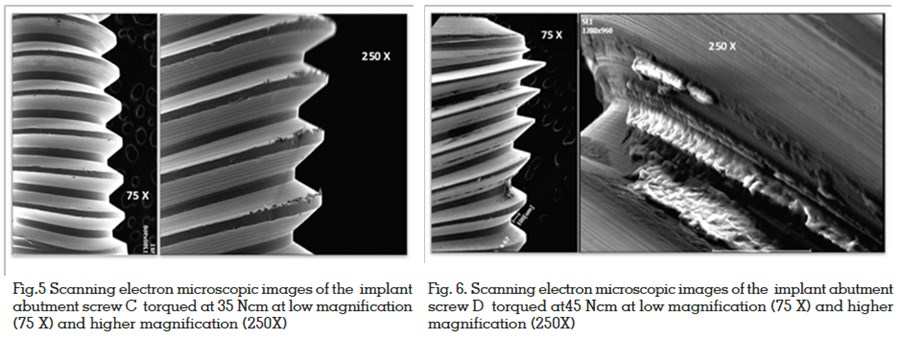

Statement of problem: Screw loosening of dental implants is one of the most common problems in prosthodontic practice. Despite known factors for screw loosening, the possible role of torque magnitude as a function of preload on the implant surface morphology must be explored to further understand the problem of screw loosening. Purpose: To evaluate the surface morphology of implant abutment screws under different torque magnitudes. Materials and methodology: Dental implant abutment screws of CMI, Neobiotech, South Korea were torqued to 15, 20, 35 and 45 Ncm on its corresponding laboratory implant analogue (3.5 X 11.5 mm). Using scanning electron microscopy (SEM) imaging, the torqued abutment screws were evaluated for any surface irregularities and thread wear. Results: SEM analysis of the torqued abutment screws revealed notching, stripping and wearing of the threads. The severity of altered surfaces increased with torque magnitude, compared to the absence of wear on the untorqued control abutment screws. Conclusion: Repeated tightening and loosening of titanium abutment screws can lead to thread wear and stripping. The chronic event of the above phenomenon can lead to screw loosening and further screw fracture. Studies on enhancing the abutment screw coatings with materials of reduced coefficient of friction can decrease the incidence of screw loosening and clinical adherence to replacing loosened abutment screws of implant patients with a new abutment screw is recommended to avoid screw fatigue and fracture.
Key words: Dental implants, Implant abutment screw, Screw loosening, Preload, Implant prosthetics
Though osseointegrated dental implants are the
most predictable treatment of tooth replacement,
long-term studies have shown presence of
prosthetic complications, such as screw loosening
and screw fracture. Problems associated with the
integrity of implant –abutment screw joint assembly
continue to be a perplexing clinical predicament
for prosthodontists.1,2 Abutment screw loosening
is a recognized obstacles in successful prosthetic
implant restorations and one of the common
causes of restoration failures. In particular, the
incidence of screw loosening of 33 % has been
reported in single implant supported restorations.3
Treatment of such prosthetic complications are
further expensive and time consuming for both
patient and the clinician. Concerted efforts by the
implant manufacturers and clinicians are required
to impact the above-mentioned complications.
Factors such as preload, bending of screw joint,
settling effect, coefficient of friction, screw material,
connection geometry, implant number, implant
diameter, restoration design and occlusal table
influence the incidence of screw loosening. The
influence of each of these factors is schematically
illustrated in Fig. 1.
It is known that repeated tightening of the abutment
screws can lead to the loss of the preload. The
application of force while retightening could further lead to cold welding or fracture of the abutment
screw. The surface changes on the abutment screw
while torquing that occurs at a microscopic level
are usually not evident clinically. Understanding
wear of abutment screw at a microscopic level may
help decipher the mechanism of screw loosening.
Therefore, we aim to investigate the influence of
torque magnitude on the surface morphology of
abutment screw.
A CMI Neo Biotech dental implant lab analogue
(3.5X 11.5 mm, N2658-26, South Korea) was mounted
in type III dental stone (Kalabhai, Mumbai, India).
Five unused CMI Neo biotech implant abutment screws are manually torqued to the lab analogue
to the values of 0 Ncm, 15 Ncm, 20 Ncm, 35 Ncm
and 45 Ncm. With the control abutment screw,
the experimentally torqued abutment screws to
15 , 20 , 35, and 45 Ncm are labeled as screw A,
B, C, and D respectively. The torque screws were
cleaned in ethyl alcohol in an ultrasonic bath to
remove residues and impurities. The abutment
screws were further subjected to scanning electron
microscopy (COX IEM-30, South Korea) under
magnifications, 75X and 250X to evaluate surface
morphological changes of torque abutment screws
such as surface irregularities, chipping, stripping
and thread wear.
Scanning electron microscopy of the control
abutment screw, reveals smooth threads under
low magnification and minor notches under high
magnification as seen in Fig.2. Further, screw A
(torqued to 15Ncm) shows uniform thread surface
at low magnification with minor notching at higher
magnification as seen in Fig.3. Screw B (torqued
to 25Ncm) also shows uniform thread surface at
low magnification with marked notching at the
apical threads as shown in Fig.4. Screw C (35Ncm)
revealed surface irregularities which were more
pronounced and were present along the entire
length of the screw as can be deciphered from
Fig.5. Furthermore, with increase of torque, screw
D (torqued to 45Ncm) shows extensive stripping
at low magnification and at higher magnification
showed severe wear of threads all along the length
of the abutment screw as seen from Fig.6.
The secure connection of the implant-abutment
surfaces often depends on the preload applied
by a predetermined amount of torque during
abutment placement on the dental implant.
Clinically, decrease in the torque value has been
reported when the implant system is in function
over occlusal load.4 Preload of an abutment or prosthetic screw is the initial load created by the
application of a torque on the screw that results
further in its elongation. Preload places the screw
in tension and leads to an over-clamping force
between the parts of the implant system. The aim
of tightening a screw using preload stress is to
maximize the fatigue life of the screw yet provide
satisfactory resistance to loosening. There are
factors that influence the preload such as the
torque magnitude, screw head design, thread
design, composition of metal, component fit,
surface condition, and diameter of the screw.5
It can be deciphered from Fig.2-6, that an increase
in insertion torque results in greater wearing of the
abutment screw threads. The surface irregularities
and notching appear to start from the leading edge
of the apical section of the screw with the torques
of 15Ncm and 25Ncm and seem to progress along
the entire length of the abutment screw at 35Ncm.
The abutment screw torqued at 45Ncm showed
extensive stripping. Increased torque magnitude
can damage the abutment threads, reduce the
preload over a period of time and further lead to
screw loosening and under constant load, lead
to fatigue and fracture. The results of the study
are further confirmed by the incidence of higher
preload resulting in reduced micromotion with a
more stable joint assembly.2

To overcome the above stated problem of
preload loss and prosthetic complications of
screw loosening and fracture, abutment screws
with modified or enhanced surfaces have been
promoted to help reduce the coefficient of friction
and generate greater rotational angles and
preload values.6–8 Several implant manufacturers
attempted to lessen the incidence of screw
loosenings through coatings on the abutment
screws. Implant Innovations Inc (3i, West Palm
Beach, Fla.) tailored the palladium-gold abutment
screw surface with a solid gold lubricant with
0.76 μ thickness to decrease the coefficient of
friction and increase preload by 24%. Further,
Steri-Oss (Nobel BioCare USA, Yorba Linda, Calif.)
modified the surface of its titanium abutment screw
through a polytetra fluoroethylene polymer (Teflon)
spray coating to decrease friction by 60% and
increase fatigue strength.7–9 When titanium slides
in contact with other metals of similar hardness,
the coefficient of friction is initially low; however,
with repeated tightening and loosening, the values
of coefficient friction gradually increases to that
of titanium implant against titanium abutment
surfaces.7,9 This increase in the friction coefficient
to galling (wear caused by adhesion between
two sliding surfaces) and seizing (cold weldingactual
freezing together of the threads) tendency of
titanium alloys. Reducing the coefficient of friction
and enhancing the tightening speed, increases
the angle of turn of the coated abutment screw at
the target torque. As the angle of turn increases,
the elastic energy and preload also increases.
Additionally, an increase in the coefficient of
friction, increases the frictional dissipation energy
leading to a decrease in preload.7
Limitations of the study are that the cyclic
loading was not used as it could have simulated
the masticatory cycles, use of manual torque
wrench instead of digital torque wrench, use of
single implant manufacturer and using torque
magnitude as a function of preload. The results can further be validated through evaluation of
surface roughness parameters such as Ra, Rq with
Optical Profilometer and Atomic Force Microscopy.
Repeated tightening and loosening of titanium
abutment screws lead to thread wear, stripping
and eventually screw fracture. Understanding the
effect of the coefficient of friction and tightening
speed on preload can improve the stability of
joint surface characteristics, tightening speed and
reduce the incidence of screw loosening. Clinically
replacing the loosened abutment screw in a patient
with a new abutment screw is recommended and
a safer choice to prevent prosthetic complications.